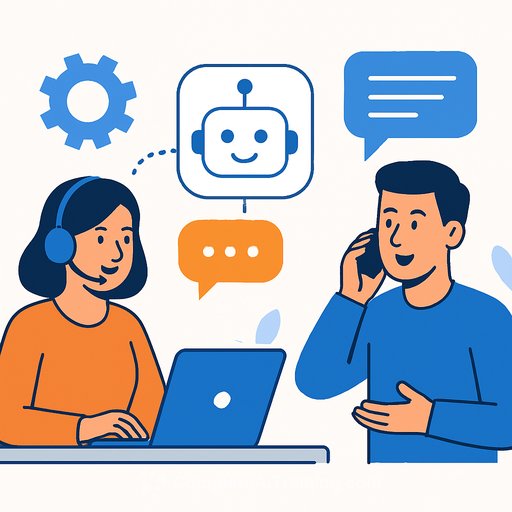Do consumers really want to talk to bots? A practical playbook for support leaders
Short answer: yes for speed, no for stakes. Most customers still want a human when the risk or emotion runs high. But comfort with AI is rising fast, and the split depends on age, problem type, and industry.
Here's how to design your support stack so it feels fast when it should and human when it must.
What the data actually says
Gartner's 2024 research found 64% of consumers would rather companies didn't use AI for service at all. That hesitation comes from years of rigid menus and dead ends.
But sentiment is shifting. Zendesk's 2025 CX Trends shows two-thirds of people are happy to offload routine tasks to an AI assistant, and 64% trust bots more when they sound human-like. The pattern is clear: customers accept automation when it's accurate, personable, and useful.
Leaders are planning for a hybrid. Nearly half expect bots to check intent, solve the easy stuff, and then hand off to a person for judgment-heavy cases. That's the sweet spot for now.
- Zendesk CX Trends highlights the link between "human-like" tone and trust
The age factor: segment by comfort, not just channel
Younger customers (<35) are far more open to chatbots and voice assistants. Pew's 2025 polling showed 18-49 year-olds are more likely to rate chatbots as helpful for speed and acceptable on quality. They grew up with messaging, so AI feels like a normal extension of the experience.
Comfort drops with older customers. A 2024 UK survey found only 23% of people 55+ were comfortable with AI-mediated communications. Many will use digital channels but expect a visible, fast path to a human.
In the middle (35-54), preferences are situational. Verint reports 47% prefer humans but accept bots if the issue is resolved quickly. Pragmatic, not ideological.
- Default routing: give digital natives a "concierge" bot that's quick and proactive
- Offer clear, respectful "talk to a person" options for older customers
- Always show the exit: a human is one tap away
Industry differences: where bots win-and where they don't
Retail and ecommerce
Bots work well for order status, returns, and FAQs. Acceptance jumps when interactions are fast, accurate, and friendly. Transparency helps: label the bot clearly and set expectations upfront.
Banking and financial services
Routine tasks are fine (balances, card freezes), but credibility and compliance matter. The Consumer Financial Protection Bureau has warned that poorly designed chatbots can misinform customers and increase risk.
- Use bots as a first line for convenience
- Escalate immediately for disputes, fraud, and claims
- CFPB guidance on bank chatbots
Telecommunications
Customers like quick bots for data usage checks and device resets. Satisfaction plummets when billing or coverage issues get stuck in automation. The handoff must be seamless and fast.
Healthcare
Great for admin: scheduling, benefits, insurance verification. For anything clinical or emotional, patients want a human. Accuracy and empathy are non-negotiable.
The psychology behind bot acceptance
- Familiarity: frequent AI users bring their comfort with them
- Control: visible escape routes reduce anxiety and boost satisfaction
- Tone: warmth, clarity, and conversational phrasing increase trust
- Context: low-risk tasks are fine for bots; high-stakes issues need people
Customers don't reject AI-they reject bad AI experiences.
Design the hybrid: assist, then hand off
- Use bots for intent checks, data gathering, and simple resolutions
- Trigger escalation based on risk, sentiment, or failed attempts
- Expose escalation early: "Need a person?" should be obvious from the start
- Tune tone by segment: quicker pacing for digital natives, guided steps for less confident users
- Enable sentiment detection to auto-escalate frustration or confusion
Operational checklist for support leaders
- Map intents by risk: automate low-stakes; route high-stakes
- Set channel SLAs: bot-to-human handoff within X minutes or Y messages
- Instrument containment the right way: celebrate "good containment," not deflection at all costs
- Track CSAT/CES by age band, channel, and issue type
- Give agents bot summaries and suggested actions to cut handle time
- Run weekly QA on transcripts: tone, accuracy, escalation timing
- Create a "human override" keyword customers can type any time
Playbook by scenario
- Order status, simple returns, password resets: bot-first, 100% self-serve
- Billing questions, service outages: bot triage, fast human escalation if unresolved in 2-3 turns
- Fraud, healthcare concerns, legal disputes: direct-to-human or immediate bot pass-through
Team training and tooling
Great CX comes from orchestration, not a single tool. Train agents to collaborate with bots, read bot summaries critically, and own the handoff with empathy. Keep your copy library tight so both humans and bots sound consistent.
If you're skilling up your support team on AI workflows and prompt craft, explore role-specific learning paths here: AI courses by job.
Bottom line
Consumers are moving from suspicion to selective acceptance. Bots have earned the "speed" layer; humans still own the "stakes."
Build for both. Design the assist. Perfect the handoff. That's how support feels efficient and genuinely human at the same time.
Your membership also unlocks:





